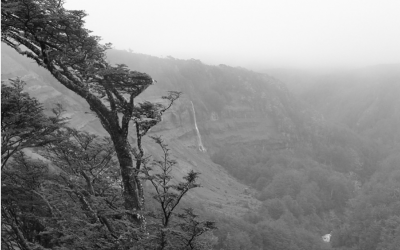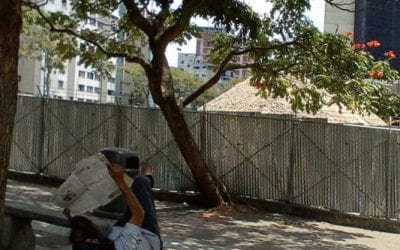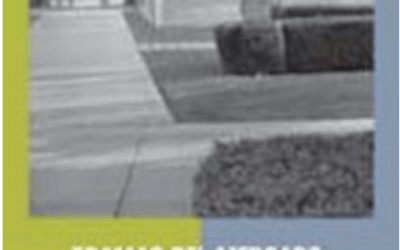A Design Revolution
Caracas on the Margins
We write with a sense of urgency as we hear the deafening sounds of the city. When we read that the price of oil has rocketed to more than $140 a barrel, here in Caracas we are reminded of the impact of oil on the development of our city, first by despotic petro-populist development and later by hyper real petro-dollar development. Caracas continually faces blind building aggregation and arbitrary political decision-making, but as our colleagues John Beardsley and Christian Werthmann stress in their groundbreaking exhibit “Dirty Work: Transforming the Landscape of Non-Formal Cities in the Americas” at the Harvard Design School, architects need to address this development. We must develop new tactics to deal with the massive economic, environmental, infrastructural, and social failures of recent urban excesses in the Global South. As indicated by our participation in that exhibit, we believe that as informal settlements become increasingly prevalent throughout the world, successful local projects could establish a framework for practices that would translate to other comparable global cities.
The Metrocable
Our most recent design initiative in this context is the Metro Cable project, showcased at the Dirty Works exhibition. An aerial ropeway offers an alternative access system to residents of the marginal San Agustin neighborhood, connecting more than 40, 000 people with the Metro system of Caracas. When in 1993 the government proposed to put a road network through the barrios (as the informal settlements are called here), displacing up to a third of inhabitants and disrupting their way of life, the local community was in uproar. The Urban Think Tank (U-TT) team acted and developed this design solution with international expertise, Austrian company Doppelmayer Ropeways and the local community. The government backed down and the first line is due to open next year.
U-TT proposed additional programs in each of the five stations to meet community needs, such as a vertical gym, a rehearsal space for the Venezuelan Youth Orchestra, a radio station with a public viewing platform and multiuse green spaces.
This connect-the-dots transport scheme has the considerable virtue of being cost-effective and minimally invasive of the community fabric, woven into it only at five discrete points. The hilltop stations, set into densely built neighborhoods, rest on stilts to avoid all but the absolutely essential demolition of homes. Like the gondolas themselves, the stations float above the ground, a near-perfect expression of an ideal intervention: one that facilitates and connects without imposing, that emerges literally and figuratively from the community it serves. It avoids urban restrictions by physically connecting the community of the barrio with the infrastructure of the ‘formal’ city.
Beyond Architecture
After working in Latin America for more than 20 years, we believe that developers, city administrators, architects and planners not only have the ability but also a responsibility to be part of a sustainable city creation. Cities call for design focused on needs, not just on form creation. Today, globally, almost every design discussion focuses on what the design means and whether it will sell rather than on what it does. Hence understanding the performative and social role of architecture becomes paramount. Furthermore, all intelligent planning and design should be resistant to the inevitable political and economic fluxes that lie ahead. This cannot be achieved without the active contribution of technology transfer and research funding from leading corporations such as oil companies.
In 1998,we established the Urban Think Tank, both as a private research center and independent practice engaged in architecture, urbanism, and cultural studies. We are committed to fostering a collaborative, multidisciplinary research community that brings together science, art and professionals whose ideas and work will broaden the vision of city administrators and encourage them to explore previously ignored and uncharted realms of the various configurations of the Latin American Metropolis. We seek to assist communities and those who represent their various interests in building a literal and figurative common ground, based on the principles of tolerance, cohabitation, and sustainability, by making available to them new knowledge and a new set of architectural principles that respond to the social realities of the contemporary Latin American city .
Cities are traditionally studied in the context of a single discipline: economics, politics, media studies, ecology, architecture, or sociology. But an interdisciplinary approach to the creation of urban environments is essential understand what now exists and to invent inventing new paradigms for South America’s exploding cities of. The current problems of massive urbanization can not be solved in a unitary, isolated fashion, but require multiple and simultaneous approaches. Yet we have found that design schools fail to respond to the urgent problems of “real life” in the barrios, even though the southern hemisphere is in desperate need of such responsive and thoughtful projects.
Petare Neighborhood
One telling example of Caracas’s explosive disorderly urban expansion is Petare on the eastern hills of the city. Density and insecurity make census-taking virtually impossible, but the neighborhood has been thought to house close to one million residents.
The urban settlement emerged, with dramatic culminating effect, because of the construction of a highway and the subsequent chain of real estate transactions. Ironically, such public works, intended to modernize and improve living conditions and to integrate communities, have resulted in even greater segregation, raising nearly insurmountable barriers.
Construction of the highway took a decade, during which time Petare’s foothills were occupied by workers’ barracks, making it eventually a prime site for squatters. Ongoing negotiations between the landowners whose property was seized for highway construction and the local municipality resulted in eventual compensation for the landowners, who were allowed through an ordinance to construct a 14-story residential towers on the flat land along the highway. Inhabitants on both sides of the highway suffer from missing or badly maintained infrastructure, poor security, drug-related crime, and the absence of public spaces and recreation. Each side has fortified itself against the other, and everyone blames everyone else.
There have been many critical junctures and revelations in the course of our work, but our first walk through Petare was a major turning point. Horacio, one of the original founders of the Julián Blanco Petare Norte sector in the barrio, invited us to have coffee in his house. Standing in the passageway looking out through the open concrete frame, we saw the most extraordinary urban space. We were inside a mountain of interlocking red brick houses,looking out over the ruins of the modern city. From that vantage point, we saw a deconstructed landscape of raw red block, a massive construction site of detached concrete pillars and steel scaffolding. Nothing in our past training in New York and Vienna had prepared us for that reversal of perspective, for seeing the city as barrio dwellers do. That experience was the impetus for our efforts over the past ten years, which have focused on designing and building small projects that could eventually lead to a city based on connections between the planned and unplanned.
We have also come to understand that the informal development of cities is a global phenomenon; it fills every space left by the erosion of regulated structures in cities around the world. In the large cities of the developing world, the speed of decline in social services, welfare, housing, public schools, and income from taxes has been enhanced by population increase and the resulting growth of informal settlements. This is especially evident in cities like Caracas, which have not adapted fast enough to their new economic and social realities.
In Caracas, poverty has always been in the background – pervasive but unacknowledged. Now that the poor are organizing, acting, asserting their rights – not least the right to vote – and assuming the duties of citizenship, they are increasingly more difficult to ignore or marginalize. And it is significant that the freedom they seek is less a matter of being relieved of burdens than of being permitted to be engaged in and take responsibility for their lives, homes, and future. Thus our focus on the poor is not a matter of “uplifting” them, but of learning from and applying the social and urban transformations initiated by their community organizations
A particular challenge in our work has been to develop design solutions that respond equally to community needs, financial limitations, and a vision of the future – to find the best balance of pragmatism and idealism. One approach is what Ignasi Solá Morales has defined as “City Acupuncture,”small-scale, highly localized interventions. These pilot projects are quickly completed, sometimes with only sketchy construction drawings, and have a direct, measurable effect on the immediate community. We think of this as “street vendor architecture.” Among the first of these was the Mama Margarita Orphanage for street children. The community had no financial support from the government; we were enlisted to identify a site and develop a low-cost design solution. The site we found under a highway bridge in Petare—like that for another project, the Vertical Gymnasium in the barrio La Cruz in Chacao, or the urban cable car project, now under construction. What these projects have in common is that all were abandoned municipal spaces that have now become a focal point for the desired community.
Because Caracas is our home and the Global South our culture, we developed subversive architectural ideas that have allowed us to endure our innovative yet complex practice in Caracas. From systematic propositions of public spaces under highways to the construction of instant activist architectures, we find no time for incubating in the traditional sense of the profession; instead, we negotiate conventional and unconventional practices.
Thus U-TT has deliberately shifted from the formal traditional master plans to a strategy of activist architect who operates as initiator, mediator and designer. The speed at which changes take place in urban space suggests specific places and conditions, so the design and construction of this space constantly require regenerating mechanisms which address the particular factors of the various places and their interaction with global changes and systems. For institutions, the idea of a global process is an attempt to simplify and control all possible forms of behavior and action. We propose urban models that aim to reflect the spatial necessities of a society in need of equal access to housing, work, technology, services, education and resources as a principal right for all city dwellers.
Alfredo Brillembourg and Hubert Klumpner are founders of the Urban-Think Tank in Caracas. Their work on the San Agustin Metro Cable was featured at the exhibit “Dirty Work: Transforming the Landscape of Non-Formal Cities in the Americas” at the Harvard Design School.
Related Articles
Editor’s Letter: Venezuela
Long, long ago before I ever saw the skyscrapers of Caracas, long before I ever fished for cachama in Barinas with Pedro and Aída, long before I ever dreamed of ReVista, let alone an issue on Venezuela, I heard a song.
Elections and Political Power: Challenges for the Opposition
English + Español
Next month’s elections will be an important benchmark in Venezuelan politics. On November 23, voters will go to the polls to elect 22 state governors and 355 mayors in as many municipalities, as well as choose the mayor of Caracas. The elections are taking place in a political environment influenced by the abrupt proclamation of 26 laws on July 31, the last day of President Chávez’s 18-month powers to issue emergency decrees …
A Review of Tramas del mercado: imaginación económica, cultura pública y literatura en el Chile de fines del siglo veinte
Luis Cárcamo-Huechante’s new book provides us with a convincing counter-narrative, at once nuanced and succinct, to three mainstream narratives of the neoliberal free market in Chile: those of monetarist economics, promotional politics, and literary bestsellers. It covers the Pinochet dictatorship (1973-90) and the transition to democracy from its official inauguration in 1988, with the victory of the Yes vote for a return in two years’…




